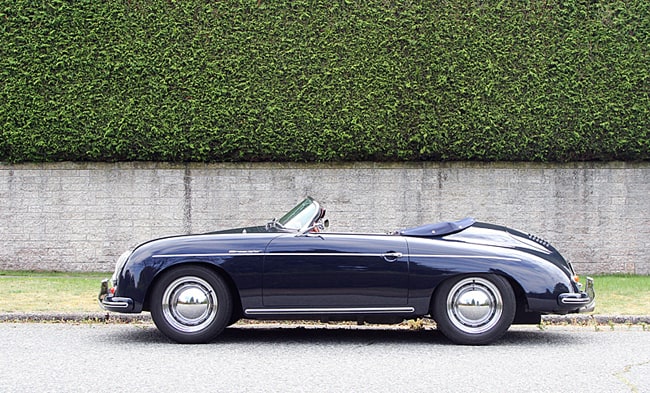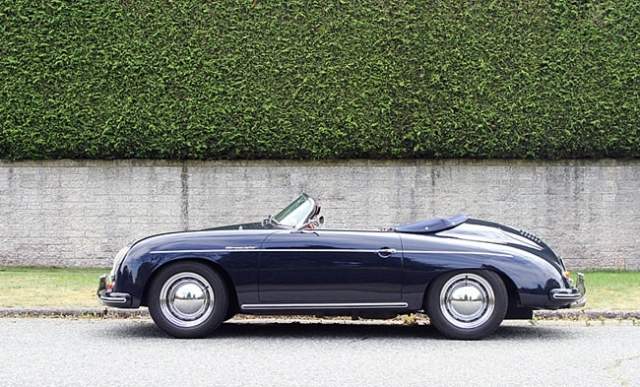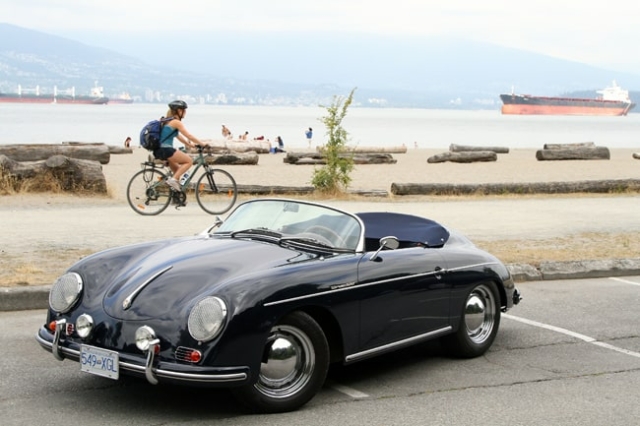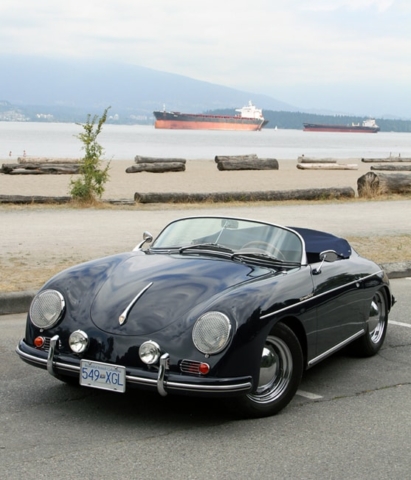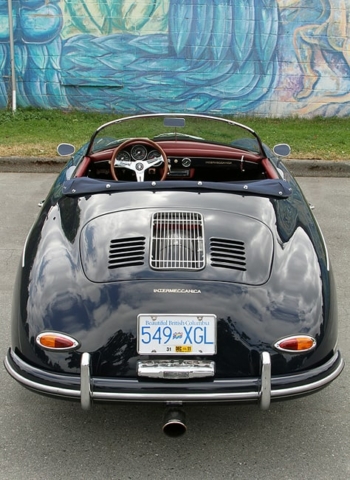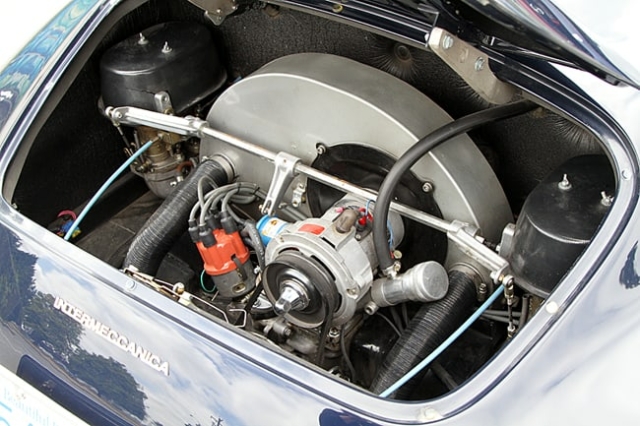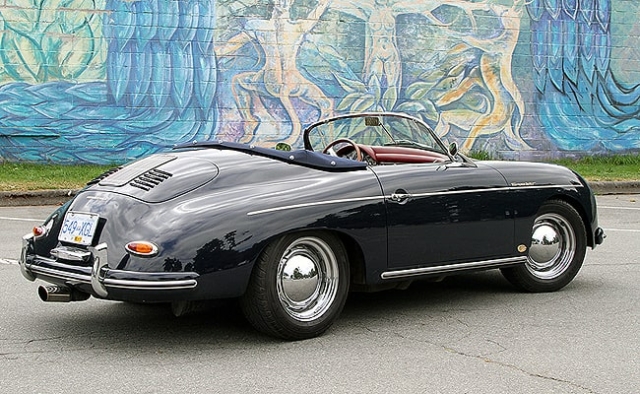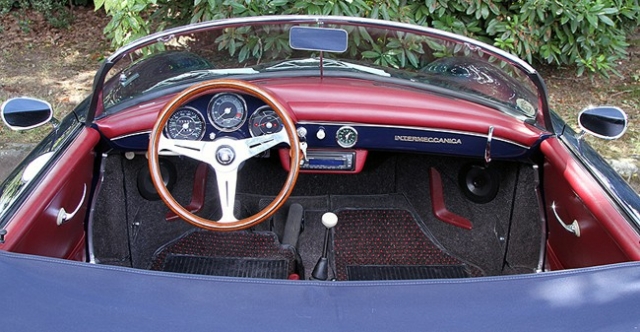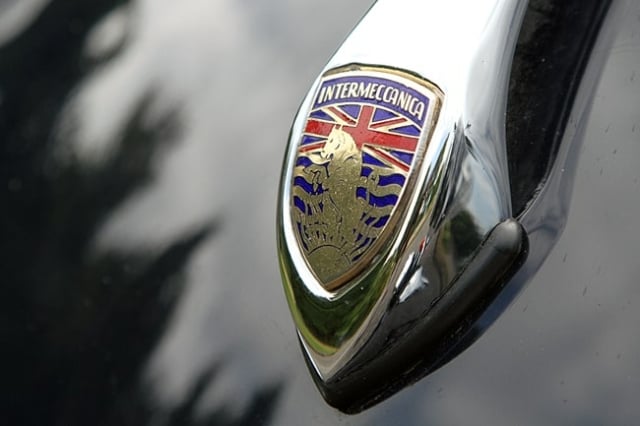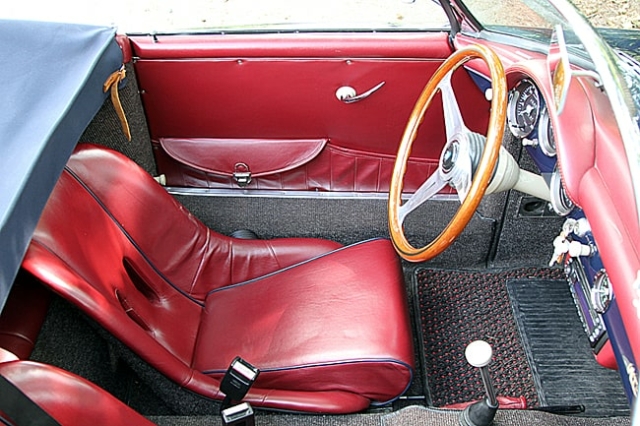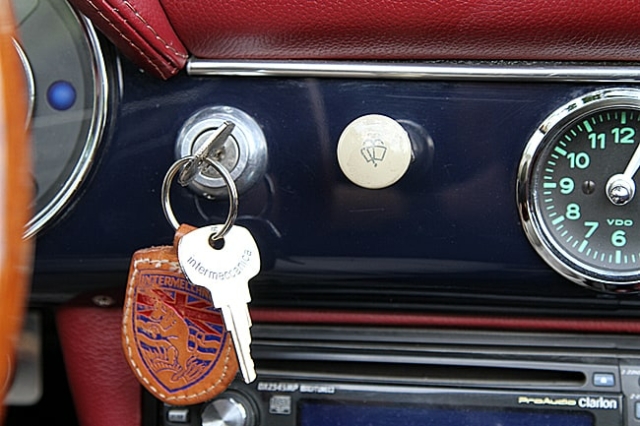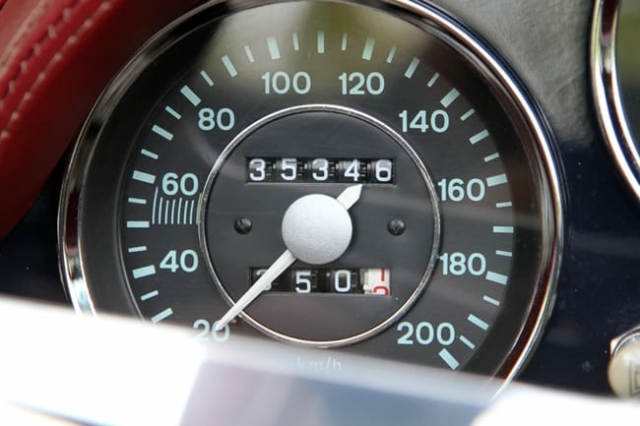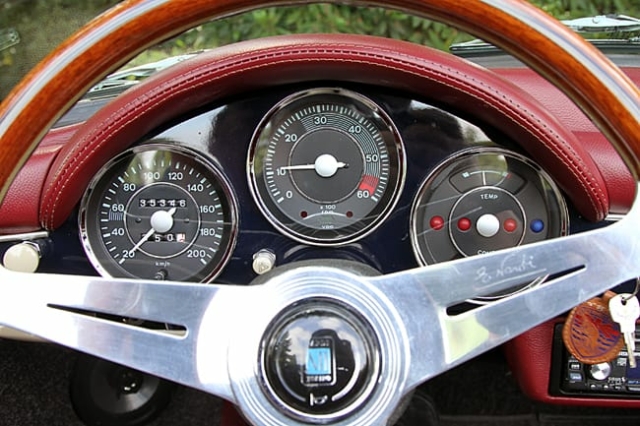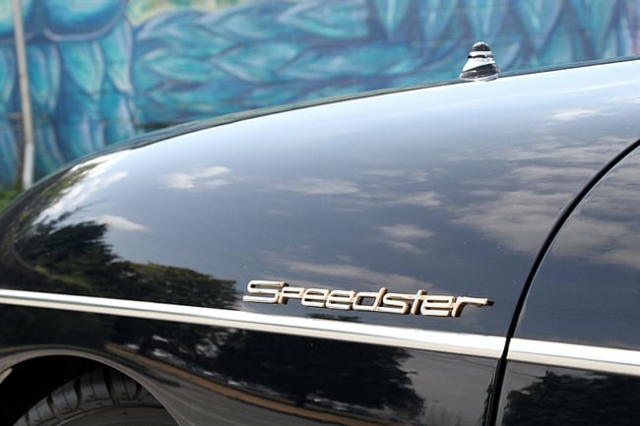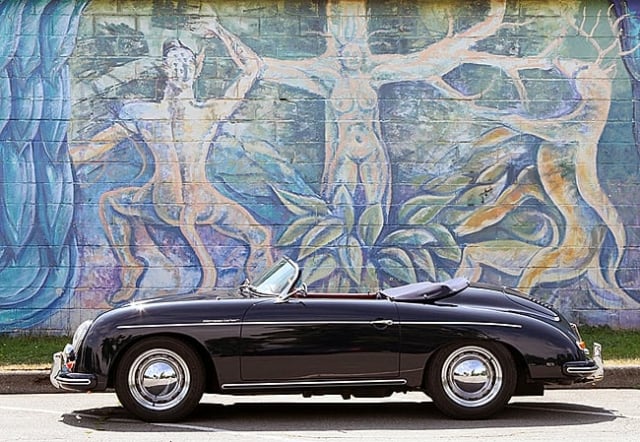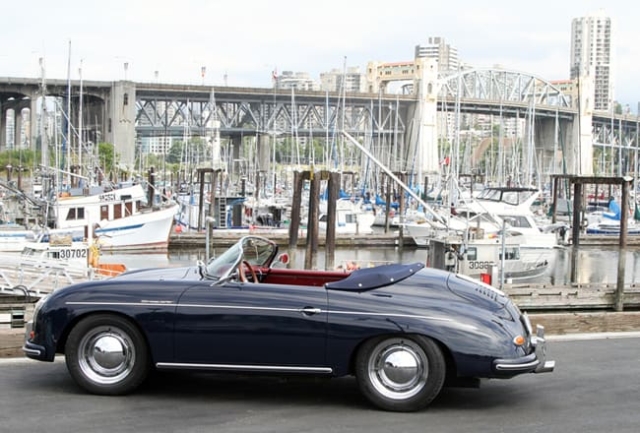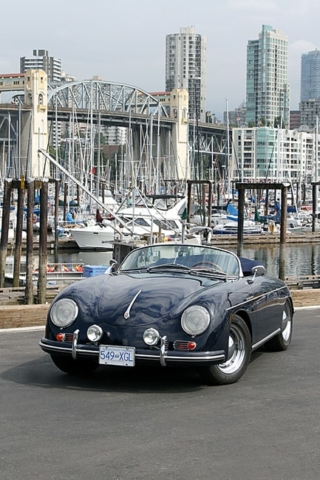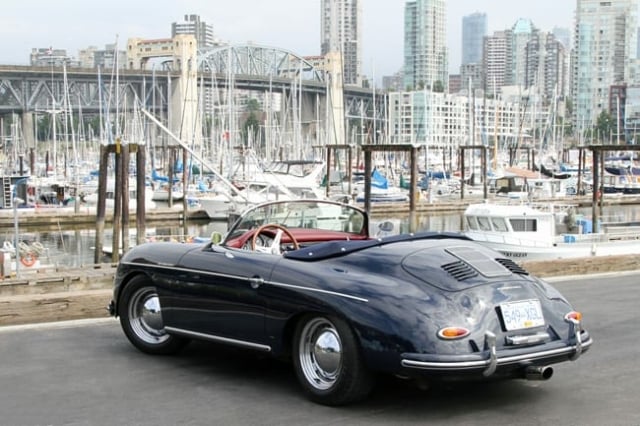I am privileged enough to get the opportunity to drive a wide variety of automobiles, but few, if any, have delivered a driving experience more enjoyable than that offered by the Intermeccanica Speedster.
A 1958 Porsche 356A Speedster Reimagined
The Intermeccanica Speedster is a faithful reproduction of the 1958 Porsche 356A Speedster- a car that has ranked very high on my list of dream machines since I was a young boy. I recently had the opportunity to spend the day behind the wheel of one of these hand-built beauties and must admit, the experience was eye-opening in more ways than one.


My test vehicle was the personal vehicle of Intermeccanica principal Henry Reisner, and as such, was well-sorted and impeccably maintained. The car was lovingly constructed in 2004, and is cloaked in a deep blue paint (Porsche’s Midnight Blue) and features a matching high-bow, canvas top. Customers can order the low-bow structure, but taller individuals will appreciate the extra headroom offered by the taller unit.
Vintage Porsche Interior with a Modern Touch
Luckily for me the top was down when I picked up the Speedster as I stand 6’2″ tall and am large in stature. This made getting in and out of the svelte little convertible a much easier proposition. The compact doors are ultra-lightweight and open with ease, but it is necessary to step over a fairly wide sill before sliding your legs into the expansive foot-well and lowering yourself into the driver’s seat.


Once seated I was taken aback by the fact that this very small sports car provided a surprising amount of space for a big lad like myself to move about. Immediately you notice that most of the real-estate under the dash is visible and exposed, and that there is no central tunnel to demarcate a boundary between the two seating positions. This allows the gearshift and pedals to take centre stage. I will admit that this layout does help give the diminutive car’s passenger area a more spacious feel, but this is also aided by the fact that the Intermeccanica Speedster features a wider tub than its Porsche namesake.
The low-slung windshield and Spartan interior left me feeling free and unencumbered when driving with the top down, but later in the day, after snapping the top in place, I will admit that I did suffer from a little bit of claustrophobia. This is due to the fact that the roof design partially conceals a portion of the side windows (modern, power-operated side windows replace the side curtains of the original car) which greatly impedes on outward visibility for taller individuals like myself.
The Speedster’s tidy cockpit featured a pair of low-back bucket seats swathed in bright red Italian leather hides accented by dark blue piping. While not a requirement, leather interiors have proven to be the choice of most of the Vancouver firm’s customers. These thinly padded seats were surprisingly supportive and proved comfortable enough over the course of the day. Modern seatbelts have been added to the design for safety reasons, but don’t expect to see any airbags (or headrests for that matter) in a Speedster re-creation.

Most German manufacturers utilized square-weave, wool carpeting in their automobiles during this time period (1950’s), and the quality of that used by the craftsmen at Intermeccanica is impressive. It has been selected to be as close a match as possible to that used in German sports cars of the period, and gives a classy look and feel to the Speedster’s passenger compartment and trunk.
The view from the driver’s seat features an uncluttered dashboard sporting a trio of reproduction VDO gauges, a simple clock, and a couple of simple pull knobs. The highly polished, wood-rimmed Nardi steering wheels is a simple three-spoke design that offered a comfortable grip and slipped easily through my hands. The simple floor-mounted shift lever fell readily to hand, and the flow of its action provided plenty of positive feedback.
Powered by a 165-horsepower Volkswagen Type 1
Under the shapely hood of Reisner’s Speedster resides a 2.3-litre, four-cylinder engine based on the venerable Volkswagen Type 1 engine which provided the motivation for early Volkswagen Beetles. This power plant is Intermeccanica’s largest displacement air-cooled offering, and it produces a healthy 165-horsepower and 155 lb-ft of torque.

Intermeccanica sources its air-cooled engines from C.B. Performance in California, a specialist firm dedicated to the production and distribution of high-performance Volkswagen engines and components. The engines themselves are brand -new units which have been highly modified to enhance performance and increase reliability.
My test vehicle was extra special as the engine had been coupled with a Porsche five-speed manual transmission sourced from an early 911. As a result, it had a very unique shift pattern. First gear is a dog-leg over towards the driver and down, while reverse gear is situated where the traditional first gear would be on a modern manual gearbox.
This proved to be a really nice combination for the enthusiast driver as I was told that this particular engine tends to be a bit peakier than the smaller displacement engines fitted to the entry level offerings in the Intermeccanica line. The engineering goal was to give the driver of this car the proper tools to extract peak performance from the car’s engine, and by adding the extra gear (original cars were 4-speeds) it is much easier to keep the car in the sweet spot of its power band. It is also nice to have the taller gear when cruising at highway speeds as well.

This particular vehicle also features four-wheel power disc brakes, rack-and-pinion steering, and stout, anti-sway bars. Mr. Reisner explained that he felt that these are very nice upgrades to have in the vehicle as while it may look like a 50-year-old car, these alterations allow it to drive and react like a much more modern design. He feels that mechanically, the company’s cars represent a good bridge between the old and the new. The Intermeccanica customer is still able to appreciate the distinctive sounds and smells that come with an air-cooled car, but due to some mild upgrades they are able to experience improved drivability and a higher level of performance.
Driving impressions: how does the 1958 Speedster coupe perform?
The performance of the 1958 Intermeccanica Speedster was much more impressive than I was expecting. I should point out that on the day of my visit I had arrived at the shop behind the wheel of a brand-new Porsche 911 Carrera. Few would argue that the 911 is one of the best handling automobiles in the world today, and as a result, Porsche can’t produce enough of the iconic machines to satisfy demand. However, upon my return from an afternoon of open top motoring in the Speedster, I must admit that I came away with a new appreciation for the experience of driving.
I was initially attracted to the Intermeccanica Speedster because of my love for the classic design. It’s curvaceous body and clean lines hint at a much simpler time when cars were far less complex, light on equipment, and invigorating to drive.

The Speedster is a model of simplicity, and it was a pleasure to embrace the act of actually driving a car rather than being isolated from the process. Modern automobiles are so cluttered with computers and electronic safety nannies that much of the fun and excitement has been removed from the driving experience.
This is not the case with cars like the Intermeccanica Speedster where simple mechanics, responsive handling and a lightweight design help the car communicate with the driver through the seat, controls, and visceral feedback brought on by the cacophony of sounds produced by the engine, exhaust system, and squealing tires.
The driver remains in complete control over the vehicle’s operating functions, and will be consulted largely through the seat of his (or her) pants when it comes to making decisions about how and when to manipulate the steering wheel and gearbox, or apply acceleration and braking inputs.
The car performed flawlessly for the bulk of my day as I tackled downtown traffic, toured the winding roads around Vancouver’s many beaches, and took a couple of laps through Stanley Park.
Once the car’s engine and drive train were sufficiently warmed up and I was comfortable with the novel operation of the Porsche gearbox I began to explore the capabilities of the Speedster. I found the car to be well-balanced, and very civilized when it needs to be, but when given the opportunity to reveal its true performance and handling prowess you quickly realize why the original car was such a world-class sports machine. Acceleration is brisk and exhilarating as the car weighs in at a mere 1,850 pounds. The big disc brakes had no problem bringing the agile car to a stop, and I found that the feel of the brake pedal remained positive throughout the day..
The engine in a Porsche Speedster is mounted at the rear of the car, just aft of the rear axle. To balance the weight distribution the fuel tank, tools, and spare wheel are housed up front. Intermeccanica has improved on the original design by moving the engine and transmission a full three inches forward of that of the original, and incorporating a more modern rear suspension set-up. The end result is more predictable handling with far less tail wag. At slower speeds the car remains perfectly planted when cornering, but when goaded with an extra surge of power, the rear of the car will swing out just enough to induce the formation of a mischievous smile on the face of the driver.
The car performed flawlessly for the bulk of my day as I tackled downtown traffic, toured the winding roads around Vancouver’s many beaches, and took a couple of laps through Stanley Park. The relatively short throws of the gearbox began to become intuitive as I explored Vancouver and its more interesting neighbourhoods in my stylish retro-mobile. I had been advised upon my departure that the car would deliver a very enjoyable driving experience if I made my gear selections as the tachometer approached 4,000 RPM. Henry had his car tuned so that peak power occurs at 5,500 RPM, and the few times the needle managed to kiss that mark I must say that the car really needed to be reined in. I suspect that this thing would be a blast at a track day!

So, how much will a Intermeccanica’s rare Speedster coupe cost you?
If you are looking to order a bare-bones, entry level, air-cooled Speedster reproduction from Intermeccanica it would cost you about $46,000 before taxes. The company also offers its customers the option of selecting a liquid-cooled crate engine for your car sourced from either Volkswagen (2.0-litre /125hp) or Audi (1.8-litre turbo / 185-hp). These units have proven so popular that they now make up the bulk of the company’s orders, and average cost is about $60,000. A top-of-the-line car with full Porsche running gear and a host of optional equipment would probably break the $100,000 barrier.
If you were to place an order with the company it would take about three-and-a-half months to hand build your car, but turnaround time depends on production backlog. As the company only builds about 20 cars each year, Reisner predicts that at the time of this writing it would take four to five months to get your car completed and delivered.
The 1958 Porsche 356A Speedster is one of those ground-breaking automobiles that every enthusiast dreams about owning, or at least driving, at some point in their lives. Unfortunately, only 551 of the lightweight sports machines were produced that model year, making the likelihood of ownership pretty slim, and exorbitantly expensive.
Luckily, there are companies like Intermeccanica International around to help motor-minded customers fulfill their automotive dreams without breaking the bank.
The Pros
- Classic good looks
- Superior craftsmanship
- Delivers a pure driving experience
The Cons
- Roof design is awkward for taller individuals
- Not great for four season use
- Suffers from the replica stigma

